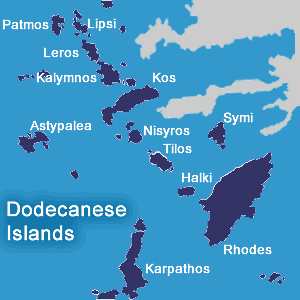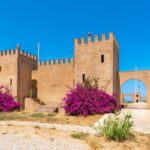Kos island, Greece, sits bang in the middle of the Dodecanese chain of Greek islands that hug the Turkish coastline between Rhodes. to the south, and Patmos, in the north. Kos holidays are hugely popular with British package tour firms.
Kos is one of the best islands in Greece when it comes to a typical beach holiday. It was among the first to go for mass-market tourism in a big way with many Kos hotels thrown up on the long, sandy coastlines to the east and the south.

Kos is long and thin, about 45 by 11 kilometres and, unlike many other Greek islands, it’s mostly flat and low-lying, especially in the north and west. As a result, much of the scenery on Kos is not outstanding by Greece standards, although it does get more mountainous in the south and east.
The lack of hills has helped to make cycling a very popular Kos holiday activity and there are no end of bicycle rental outlets and even dedicated cycling lanes between the big holiday hotels.
As well as the brash nightlife of Kos Town and a plethora of beach resorts, the island also boasts some of the best archaeological sites to be found in the Mediterranean.
For many though, it’s the long, sandy beaches that make a holiday to Kos so appealing with day trips by boat to nearby Turkey a very popular holiday excursion.
Kos airport is one of the busiest in the Greek islands and attracts international charters from all over the world. It lies to the west of the island some 26 kilometres from Kos Town – a long way for east coast holidaymakers but handy for the main south-west beach resorts at Kamari and Kardamena. A daily bus service runs from Kos Airport to the east coast passing through north coast resorts like Mamaris, Tingaki and Mastichari.
Although a few ferries dock at Mastichari, the main ferry port is in Kos Town where the Dodekanese Seaways operate services to most other islands in the Dodecanese group while other ferries run daily to other island groups and local companies run regular day trips to Turkey.
Whether travellers are seeking adventure, relaxation or cultural experiences, Kos delivers a holiday they will never forget, fostering an unforgettable sense of discovery and wonder.
Getting to Kos
Kos, a beautiful Greek Island in the Dodecanese, offers stunning beaches, lush valleys, and a rich history. If you’re planning a visit to Kos, there are several ways to get there, which I will detail for you below.
By Air
Kos has its own international airport, Kos Island International Airport (KGS), which accommodates flights from several European cities during the peak summer season. Some of the main airlines operating flights to Kos include:
- EasyJet
- Ryanair
- British Airways
- TUI Airways
If you’re travelling from outside Europe or during the off-peak months, you’ll likely have to catch a connecting flight. The most common route is through Athens, the capital of Greece, where you can catch a domestic flight with Aegean Airlines or Sky Express to reach Kos.
By Sea
Alternatively, you can opt for the scenic route and arrive in Kos by ferry. The island is well-connected to numerous ports in Greece, with regular ferry services operated by companies such as Blue Star Ferries and Dodekanisos Seaways.
Some of the main Greek ports with connections to Kos include:
- Piraeus (Athens)
- Rhodes
- Santorini
- Nisyros
- Symi
Kos is also reachable by ferry from neighbouring Dodecanese islands such as Leros and Kalymnos. Keep in mind that travel time and frequency of ferry services can vary depending on the route and season, so it’s advisable to check the ferry schedules before making any bookings.
Whether you choose to arrive in Kos by air or by sea, this gorgeous island awaits you with its picturesque landscapes, ancient sites, and vibrant atmosphere.
Top Attractions and Activities
Ancient Sites
Visit the famous Asclepion, Kos’ most renowned archaeological site. The Asclepion was an ancient healing centre and plays a significant role in the island’s history. Another intriguing ancient site is the Hippocrates’ Plane Tree, located north of the Ancient Agora in Kos Town. It is believed that Hippocrates, the father of medicine, once taught his students under this historic tree’s shade.
Beaches
Get ready to relax in the sun at some of the island’s beautiful beaches. Tigaki Beach is a peaceful spot with plenty of sunbeds. Enjoy the calm atmosphere as you gaze upon the dazzling turquoise waters. For a different beach experience, try out other sandy shores such as Paradise Beach and Kamari Beach.
Outdoor Activities
Kos has an abundance of outdoor activities for all interests. Some options include:
- Cycling: Explore the island’s green landscapes on two wheels. Cycle paths are available all around the island for riders of all levels.
- Trekking: Discover hidden gems and beautiful sceneries by hiking through the island’s various paths and trails.
- Water sports: Enjoy water-based activities like snorkelling, scuba diving, and windsurfing at several of Kos’ beaches.
Cultural Experiences
For a dose of local culture, consider visiting the Archaeological Museum Kos. The museum showcases artefacts from various periods of the island’s history, offering an insightful glimpse into Kos’ rich heritage. Additionally, witness the lively atmosphere of the island’s nightlife as you explore local bars, restaurants, and traditional tavernas.
Where to Stay
When visiting the beautiful island of Kos in Greece, there are various accommodation options to suit all budgets and preferences. In this section, we will explore mid-range options, and luxury hotels for a memorable and comfortable stay.
Mid-Range Options
If you’re willing to spend a bit more for your stay in Kos, consider mid-range accommodation choices located in Tigaki and Marmari. These areas offer a balance between affordability and luxury:
These hotels provide spacious rooms, a range of facilities, and proximity to beautiful sandy beaches, making them a great choice for a comfortable and enjoyable stay without the luxury price tag.
Luxury Hotels
For those seeking indulgence on their Kos holiday, there is no shortage of luxury accommodations in the upscale areas of Kardamena and Mastichari. Some top-notch hotels include:
These luxury hotels offer exceptional services, facilities, and elegant, well-appointed rooms. Guests can expect exquisite dining options and private beach access, making their stay on Kos Island an unforgettable experience.
Eating and Drinking
Visiting Kos offers a delightful culinary experience for travellers. The island offers a range of local dishes, popular restaurants, and an exciting nightlife for visitors to enjoy.
Local Cuisine
The Greek island of Kos boasts a flavoursome and diverse cuisine. Some of the must-try dishes here include:
- Souvlaki: Skewered meat, often served with pita bread and tzatziki sauce
- Moussaka: A baked dish made with layers of eggplant, minced meat, and béchamel sauce
- Dolmades: Grape leaves stuffed with rice and herbs
- Fasolada: A delicious bean soup made with tomato sauce, olive oil, and various vegetables
Additionally, Kos is famous for its local cheeses, such as kasseri and graviera. Don’t forget to complete your meal with a glass of local wine or the popular spirit ouzo.
Popular Restaurants
Kos has plenty of dining options to suit every palate and budget. Here are a few of the island’s top-rated restaurants:
- Taverna Allemagna: Located in Kos Town, this restaurant offers traditional Greek dishes with a modern twist.
- Barbouni: A seafood-focused restaurant by the sea, known for their fresh local ingredients.
- To Perasma: Situated in Zia Village, this establishment serves delicious traditional Greek food and provides stunning sunset views.
- El Greco Restaurant: A family-run eatery in Kardamena, offering classic Greek recipes and warm, friendly service.
Nightlife
Kos boasts an exciting nightlife scene with various options for those looking to dance, drink, or simply unwind. Here’s a quick guide to some popular venues worth checking out:
- Bars: Visit clubs like Mylos or Heaven Beach Bar for a fun night out.
- Cafes: Relax in cafes such as Ciao Café Bistro with a drink, desserts, or light snacks.
- Clubs: If you’re looking for a more energetic experience, places like Starlight Club or Status Club are perfect for dancing the night away.
With its range of local cuisine, popular restaurants, and vibrant nightlife, Kos is definitely a destination where you can relish gastronomic adventures while soaking in the Mediterranean charm.
Practical Information
Currency and Tipping
In Kos, the currency used is the Euro (€). Major credit cards are widely accepted at most establishments, but it’s always a good idea to carry some cash for smaller purchases or local markets. Tipping is not compulsory but appreciated. In restaurants, a 10% tip is common for good service. For taxi drivers, you can round up to the nearest euro, and for hotel staff, a small tip (€1-€2) will be appreciated.
Safety
Kos is a relatively safe island for tourists, with low crime rates and a friendly atmosphere. Nonetheless, it’s essential to exercise general safety precautions, such as not leaving valuables unattended and being aware of your surroundings, especially in crowded areas. It’s recommended to have a photocopy or digital copy of your passport stored in a secure location in case of loss or theft.
Best Time to Visit
The best time to visit Kos is during the shoulder seasons: late April to June and September to early October. During these periods, the weather is warm and pleasant, with average temperatures ranging from 20°C to 28°C. The peak tourist season is in July and August; it can be crowded, and the temperatures may soar above 30°C. If you prefer a more relaxed atmosphere and milder temperatures, consider visiting during the shoulder seasons.
Frequently Asked Questions
What are popular activities in Kos?
Kos offers a variety of activities for visitors to enjoy. One popular option is exploring the island’s rich history by visiting archaeological sites and ancient ruins, such as the Asklepieion, the ancient healing centre, and the Castle of the Knights. Additionally, outdoor enthusiasts can take advantage of the island’s extensive bicycle lanes, while water sports such as windsurfing and sailing are also available on various beaches.
Which of Kos’ beaches are must-visit?
Kos is home to many beautiful beaches. Some of the top beaches to visit include Tigaki, known for its long stretch of white sands and clear waters; Kefalos, a pristine beach with golden sands and calm waters; and Paradise Beach, famed for its turquoise waters and ideal conditions for water sports.
What can families do in Kos?
Families have plenty of activities to choose from in Kos. The island offers water parks, such as Lido Water Park and Aqualand, as well as the opportunity to participate in family-friendly boat tours and excursions. Exploring the island’s wildlife sanctuary with its flamingos and other bird species is another popular option for families.
Is Kos good for nightlife?
Yes, Kos is known for its vibrant nightlife scene. The island features a wide variety of bars, clubs, and restaurants, particularly in the popular areas of Kos Town and Kardamena. Visitors can be sure to find something in suits their specific tastes, from lively clubs with international DJs to laid-back beach bars.
What is the ideal duration for a holiday to Kos?
The ideal duration for a trip to Kos may vary depending on personal preferences and interests. However, a 7 to 10-day trip is recommended for most visitors, as it allows enough time to explore the island’s beautiful beaches, historical sites, and enjoy various activities without feeling rushed.
When is the best time to travel to Kos?
The best time to travel to Kos is between late May and early October. During this period, the weather is reliably warm and sunny, making it perfect for spending time on the beach and participating in outdoor activities. However, it’s worth noting that July and August are the busiest months for tourists, so those seeking a quieter experience may prefer to visit during late spring or early autumn.

Born and raised on the sun-drenched island of Crete, Sofia Mavromatis is a seasoned traveler and writer with a deep-rooted love for Greece’s vibrant culture, stunning landscapes, and rich history.



